Manda Formation
The Manda Formation (also known as the Manda Beds) is a Middle Triassic geologic formation in Tanzania. It preserves fossils of many terrestrial vertebrates from the Triassic, including some of the earliest archosaurs.[1]
| Manda Formation Stratigraphic range: Anisian ~247–242 Ma | |
|---|---|
| Type | Geological formation |
| Unit of | Cynognathus Assemblage Zone Songea Group |
| Sub-units | Kingori Sandstone Member, Lifua Member |
| Underlies | None |
| Overlies | Usili Formation |
| Lithology | |
| Primary | Sandstone |
| Other | Mudstone, siltstone, marl |
| Location | |
| Coordinates | 10.3°S 35.2°E |
| Approximate paleocoordinates | 53.7°S 23.0°E |
| Region | Iringa & Ruvuma Regions |
| Country | |
| Extent | Ruhuhu Basin |
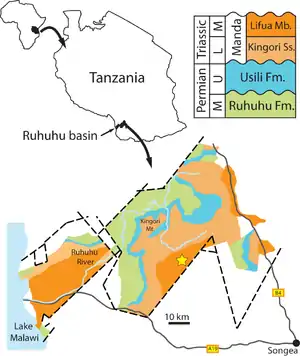 Map of the outcropping Manda Formation | |
History of study
One of the first to study rocks of the Manda Formation was British geologist G. M. Stockley. In 1932, Stockley explored the geology of the Ruhuhu Basin in Tanzania. He called a series of layers dating from the Late Carboniferous to the Middle Triassic the Songea Series and divided it into eight units labelled K1-K8. Stockley was also the first to describe fossils from these rocks, naming an older layer the "Lower Bone Bed" and a younger layer the "Upper Bone Bed".
In 1957, paleontologist Alan J. Charig described many more fossils from the bone beds in his Ph.D. thesis for the University of Cambridge.[2][3] Charig renamed the youngest of Stockley's units in 1963, calling unit K6 the Kawinga Formation, K7 the Kingori Sandstones, and K8 the Manda Formation. Fossils were identified in many strata, invalidating Stockley's division into two distinct bone beds. Since Charig's description, the Kawinga Formation has been renamed the Usili Formation, the Kingori Sandstones have become the Kingori Sandstone Member of the Manda Formation, and Charig's original Manda Formation has become a subunit of the formation called the Lifua Member.[1] Six formations and one informal unit are currently recognized in the Songea Group (Ruhuhu basin) rocks range in age from Pennsylvanian to Anisian, including the Idusi (K1), Mchuchuma (K2), Mbuyura (K3), Mhukuru (K4), Ruhuhu (K5), and Usili (K6) formations and the informal Manda Beds, which include the Kingori Sandstone (K7) and Lifua Member (K8).[4]
Paleobiota
Tetrapods
Color key
|
Notes Uncertain or tentative taxa are in small text; |
Temnospondyls
| Taxon | Member | Material | Notes | Images |
|---|---|---|---|---|
| Stanocephalosaurus pronus[5] | Lifua | Remains of a temnospondyl amphibian previously referred either to Parotosaurus or Eryosuchus[6] | ||
Parareptiles
| Taxon | Member | Material | Notes | Images |
|---|---|---|---|---|
| Ruhuhuaria reiszi[7] | Lifua | CAMZM T997, poorly preserved but complete skull and mandible | An owenettid | |
Archosauromorphs
| Taxon | Member | Material | Notes | Images |
|---|---|---|---|---|
| Asperoris mnyama | Lifua | NHMUK PV R36615, incomplete skull | A non-crurotarsan archosauriform of uncertain phylogenetic placement | 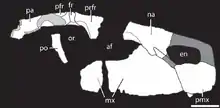 |
| "Stagonosuchus" tanganyikaensis[8] | Lifua Member | SAM 11754, right humerus | An indeterminate archosauromorph; possibly a rhynchosaur | |
| Stenaulorhynchus stockleyi | Lifua | A rhynchosaur | ||
| Unnamed[5] | Lifua | NHMUK PV R36619, incomplete skull and partial postcranial skeleton | A non-archosaurian archosauriform | |
Archosaurs
| Taxon | Member | Material | Notes | Images |
|---|---|---|---|---|
| Asilisaurus kongwe | Lifua | A silesaurid dinosauriform | 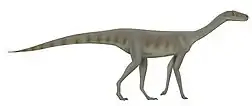 | |
| Hypselorhachis mirabilis | Lifua | NHMUK R16586, a complete dorsal vertebra | A sail-backed archosaur possibly belonging to the family Ctenosauriscidae | |
| Mandasuchus tanyauchen[9] | Lifua Member | NHMUK R6792, partial mandible and postcranial skeletons | A paracrocodylomorph | |
| Nundasuchus songeaensis[5][10] | Lifua | NMT RB48, partial skeleton and skull | An archosaur, possibly suchian | |
| Nyasasaurus parringtoni[11] | Lifua | NHMUK R6856, a right humerus, three partial presacral vertebrae and three sacral vertebrae. SAM-PK-K10654 is also potentially referable - see "Thecodontosaurus" alophos below. | A theropod or an ornithischian or the most advanced non-dinosaurian dinosauriform. Possibly the oldest dinosaur.[11] | |
| "Pallisteria angustimentum" | Lifua Member | NHMUK R36620, partial skull and some postcranial fragments | A "rauisuchian"; a nomen nudum first identified as a thecodont | |
| Parringtonia gracilis | Lifua | NHMUK R8646, a mandible, scapula, partial ischium, twelve vertebrae, and five osteoderms | An erpetosuchid | |
| Stagonosuchus nyassicus | Lifua | GPIT/RE/3831/1-21 and GPIT/RE/3832/1-15, two partial postcranial skeletons | A "rauisuchian" | |
| "Stenaulorhynchus" major[8] | Lifua Member | SAM S337, distal half of a left humerus | A subjective senior synonym of Stagonosuchus.[11] | |
| Teleocrater rhadinus | Lifua | NHMUK R6795, vertebrae, limb bones and other elements. Additional material referred from two other individuals. | An early avemetatarsalian[12] | |
| "Thecodontosaurus" alophos[11] | Lifua Member | SAM-PK-K10654, three neck vertebrae and two rear presacral vertebrae | A probable subjective senior synonym of Nyasasaurus, first identified as a sauropodomorph dinosaur.[11] | |
| Unnamed[13] | Lifua | Nearly complete skull and partial skeleton | A stem-aetosaur | |
Dicynodonts
| Taxon | Member | Material | Notes | Images |
|---|---|---|---|---|
| Angonisaurus cruickshanki | Lifua | A kannemeyeriiform | ||
| Kannemeyeria simocephalus | Lifua | A kannemeyeriid kannemeyeriiform | 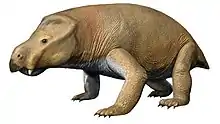 | |
| Sangusaurus parringtonii | Lifua | A stahleckeriid kannemeyeriiform | ||
| ?Shansiodon | Lifua | Skull | A shansiodontid kannemeyeriiform | |
| Tetragonias njalilus | Lifua | A shansiodontid kannemeyeriiform |  |
Cynodonts
| Taxon | Member | Material | Notes | Images |
|---|---|---|---|---|
| Aleodon brachyrhamphus | Lifua | A possible chiniquodontid | ||
| Cricodon metabolus | Lifua | A trirachodontid | ||
| Cynognathus crateronotus[14] | Lifua | A cynognathid | 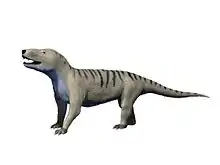 | |
| Diademodon tetragonas | Lifua | A diademodontid | 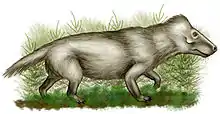 | |
| Scalenodon angustifrons | Lifua | A traversodontid | ||
| "Scalenodon" attridgei | Lifua | A traversodontid; may fall outside the genus Scalenodon and may be a synonym of "Scalenodon" charigi | ||
| "Scalenodon" charigi | Lifua | A traversodontid; may fall outside the genus Scalenodon | ||
| Mandagomphodon hirschoni | Lifua | A traversodontid; originally classified in the genus Scalenodon; named after the Manda Beds |
References
- Butler, R. J.; Barrett, P. M.; Abel, R. L.; Gower, D. J. (2009). "A possible ctenosauriscid archosaur from the Middle Triassic Manda Beds of Tanzania". Journal of Vertebrate Paleontology. 29 (4): 1022–1031. doi:10.1671/039.029.0404.
- Charig, A. J. (1957). New Triassic archosaurs from Tanganyika, including Mandasuchus and Teleocrater: Dissertation Abstracts. Cambridge University.
- Nesbitt, S. J.; Butler, R. J. (2012). "Redescription of the archosaur Parringtonia gracilis from the Middle Triassic Manda beds of Tanzania, and the antiquity of Erpetosuchidae". Geological Magazine. 150 (2): 225–238. doi:10.1017/S0016756812000362. S2CID 129115107.
- Sidor, C. A.; Angielczyk, K. D.; Weide †, D. M.; Smith, R. M. H.; Nesbitt, S. J.; Tsuji, L. A. (2010). "Tetrapod fauna of the lowermost Usili Formation (Songea Group, Ruhuhu Basin) of southern Tanzania, with a new burnetiid record". Journal of Vertebrate Paleontology. 30 (3): 696–703. doi:10.1080/02724631003758086.
- Sidor, C. A.; Vilhena, D. A.; Angielczyk, K. D.; Huttenlocker, A. K.; Nesbitt, S. J.; Peecook, B. R.; Steyer, J. S.; Smith, R. M. H.; Tsuji, L. A. (2013). "Provincialization of terrestrial faunas following the end-Permian mass extinction". Proceedings of the National Academy of Sciences. 110 (20): 8129–8133. doi:10.1073/pnas.1302323110. PMC 3657826. PMID 23630295.
- Sues, H.-D.; Fraser, N.C. (2010). "Early and early Middle Triassic in Gondwana". Triassic Life on Land: The Great Transition. New York: Columbia University Press. pp. 19–36. ISBN 9780231135221.
ISBN 0-231-13522-X
- Tsuji, L. A.; Sobral, G.; Müller, J. (2013). "Ruhuhuaria reiszi, a new procolophonoid reptile from the Triassic Ruhuhu Basin of Tanzania". Comptes Rendus Palevol. 12 (7–8): 487–494. doi:10.1016/j.crpv.2013.08.002.
- Lautenschlager, S.; Desojo, J. B. (2011). "Reassessment of the Middle Triassic rauisuchian archosaurs Ticinosuchus ferox and Stagonosuchus nyassicus". Paläontologische Zeitschrift. 85 (4): 357–381. doi:10.1007/s12542-011-0105-1.
- Richard J. Butler; Sterling J. Nesbitt; Alan J. Charig; David J. Gower; Paul M. Barrett (2018). "Mandasuchus tanyauchen, gen. et sp. nov., a pseudosuchian archosaur from the Manda Beds (?Middle Triassic) of Tanzania" (PDF). Journal of Vertebrate Paleontology. 37 (Supplement to No. 6): 96–121. doi:10.1080/02724634.2017.1343728.
- Nesbitt, Sterling J.; Sidor, Christian A.; Angielczyk, Kenneth D.; Smith, Roger M. H.; Tsuji, Linda A. (November 2014). "A new archosaur from the Manda beds (Anisian, Middle Triassic) of southern Tanzania and its implications for character state optimizations at Archosauria and Pseudosuchia". Journal of Vertebrate Paleontology. 34 (6): 1357–1382. doi:10.1080/02724634.2014.859622.
- Nesbitt, S. J.; Barrett, P. M.; Werning, S.; Sidor, C. A.; Charig, A. J. (2013). "The oldest dinosaur? A Middle Triassic dinosauriform from Tanzania". Biol. Lett. 9 (1): 20120949. doi:10.1098/rsbl.2012.0949. PMC 3565515. PMID 23221875.
- Nesbitt, Sterling J.; Butler, Richard J.; Ezcurra, Martín D.; Barrett, Paul M.; Stocker, Michelle R.; Angielczyk, Kenneth D.; Smith, Roger M. H.; Sidor, Christian A.; Niedźwiedzki, Grzegorz; Sennikov, Andrey G.; Charig, Alan J. (2017). "The earliest bird-line archosaurs and the assembly of the dinosaur body plan" (PDF). Nature. 544 (7651): 484–487. doi:10.1038/nature22037. PMID 28405026.
- Nesbitt, S.J.; Sidor, C.A.; Angielczyk, K.D.; Smith, R.M.; Parker, W. (2012). "Derivation of the aetosaur osteoderm carapace: evidence from a new, exceptionally preserved "stem aetosaur" from the Middle Triassic (Anisian) Manda Beds of southwestern Tanzania". Journal of Vertebrate Paleontology. 32 (Supp. 1): 149. doi:10.1080/02724634.2012.10635175.
- Brenen M. Wynd; Brandon R. Peecook; Megan R. Whitney; Christian A. Sidor (2018). "The first occurrence of Cynognathus crateronotus (Cynodontia: Cynognathia) in Tanzania and Zambia, with implications for the age and biostratigraphic correlation of Triassic strata in southern Pangea". Journal of Vertebrate Paleontology. 37 (Supplement to No. 6): 228–239. doi:10.1080/02724634.2017.1421548.